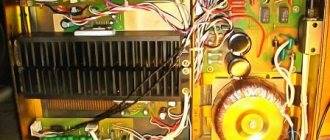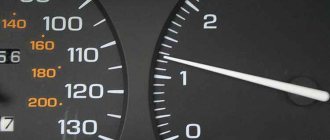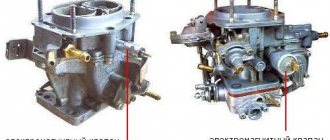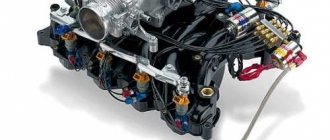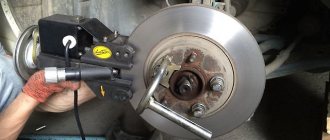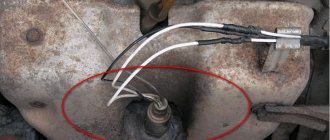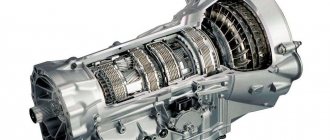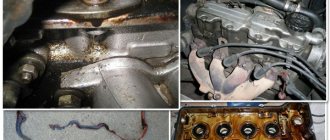Carburetor engines
The first thing that should be checked on such cars is the ignition system. A weak spark is not able to ignite a sharply increased amount of fuel. Therefore, when you press the gas sharply, a drop in speed may be observed, the spark plugs simply flood
. Check all spark plugs. They should produce a bright white-blue spark. If one of them gives a red or orange spark, then check it on the other wire. If nothing has changed, then replace it. For greater reliability, it is recommended to replace spark plugs with a complete set.
If the reason is not the spark plugs, then it makes sense to check the ignition system completely. Pay attention to high voltage wires. They must not be damaged, the insulation must be clean. To check, you will need a multimeter; use it to measure the resistance of the wire. Depending on the manufacturer, the indicator can range from 3.5 to 10 kOhm
, the specific characteristics of the wire are usually indicated on the insulation. If the resistance value is higher or tends to infinity, then the wire should be changed. There is a “folk” method of verification. To do this, start the engine in the dark and open the hood. You will immediately see the location of the current leak by a bright blue discharge. Cleaning the distributor contacts may also be helpful.
So, we checked the ignition, but it didn’t do any good. Let's move on to the carburetor. Most often, the problem is a malfunctioning accelerator pump. In this case, it simply cannot cope with the resulting load, resulting in the engine being left without fuel for a short time. To check, you will need to partially disassemble the carburetor. Before doing this, pump fuel into the float chamber using the lever on the fuel pump. Remove the top of the carburetor. Once you have access to the accelerator, press the lever that activates it several times. You should pay attention to the quality of gasoline atomization. The torch must be uniform and powerful enough. If little fuel is supplied and this happens unevenly, then it is necessary to clean the jets. Be sure to check the fuel filters.
There are 2 of them in carburetors:
- The main one is located in front of the fuel pump;
- Fine cleaning. Installed in the carburetor.
If they become clogged, failures at high speeds will also be observed. If necessary, change clogged filters. It would be a good idea to check the operation of the fuel pump. To do this, remove the central wire from the distributor (so that the car does not start), after which the fuel supply hose is disconnected from the carburetor and lowered into any bottle. Turn the starter for a few seconds. If the pump is working properly, fuel will be actively supplied to the bottle. Otherwise, replace the pump.
If you have a car with an injection engine, then the reasons for failure will be the same as with carburetors:
- Ignition;
Pay attention to fuel quality
. All modern cars are quite demanding of it. Therefore, if problems arise with the stability of the engine, check the quality of gasoline.
Cleaning and adjusting the carburetor
If you don't know why the scooter stalls when you give it gas, first check and adjust the carburetor. If it was often removed and adjusted, it may be that somewhere it began to leak air. If such a problem occurs, you can use a sealant or buy gaskets for the carburetor.
Let’s say the scooter stalls, you don’t know what to do. Then the first thing we do is clean the carburetor. Mostly the jets and auxiliary systems become clogged with dirt, so after cleaning the carburetor and adjusting all the jets, you can try to start the scooter again and give it gas. If the problem is not solved, move on to the main action - adjusting the needle to adjust the quality of the mixture. The needle in the carburetor performs the main task - adjusting the amount of fuel that is then supplied to the combustion chamber. Basically, you can adjust the quality of the mixture using a special jet on the carburetor, but if working with it does not produce results, you will have to manipulate the needle.
The needle is in close contact with the throttle handle, so when the handle is opened, the needle rises up and allows fuel to be supplied. That is, the higher the needle is raised, the more gasoline flows in and the power increases. Power guarantees better speed and traction. If you disassembled the carburetor, taking out the needle you will see 5 grooves on it, one of which has a retaining ring installed. Typically, such a ring is located in the center, that is, on the 3rd groove. If you lift the locking ring up, the needle will drop lower. This allows a leaner mixture to be supplied to the evaporation system, in which more air is supplied than gasoline. When installing the ring on the 4th and 5th grooves, the mixture becomes richer, where more gasoline is supplied than air.
Be careful that if you put the ring up or down as much as possible, this will not give the best result; the adjustment must be done gradually. Otherwise, the scooter will overheat, there will be a loss of power, and our main problem is that the scooter will stall when you press the gas handle. To find out the quality of the mixture, check the spark plug; its color will indicate whether the mixture is rich or lean.
Please note that there may also be other reasons why the scooter stalls when applying gas. Above we indicated the main ones; for some, the scooter stalls due to improper operation of the generator. Try, adjust, and share your problems and how to solve them.
Video
Why does the engine choke when you press the gas pedal?
| published 12/11/2018 |
The problem in which the engine choke when you press the gas pedal cannot be called rare. Drivers quite often encounter a situation where, when they press the gas, the car engine stalls, stops picking up speed, choke, etc.
Let's look at the reasons why the engine starts to choke when you press the gas pedal.
You can find the source of the problem by the symptoms that appear along with it:
- If the car is operated in conditions of high humidity, and the engine stalls when the gas pedal is pressed “cold”, the cause of the problem may be a simple moisture ingress.
In humid weather, condensation sometimes accumulates on the inside of the distributor cap. In such cases, the engine idles flawlessly, and the problem only appears when you press the gas pedal. This is due to the fact that at the moment of gas supply, the operation of the distributor accelerates, and the element passes a larger volume of electricity. However, condensation accumulated inside the cover causes a malfunction, and a weak spark is formed on the spark plugs, and, as a result, the engine choke.
To be sure of the source of the problem, check to see if the problem occurs with the engine well warmed up and in dry weather.
- If there is no vacuum in the fuel system, i.e. Air leaks appear and the engine also begins to choke. In this case, the problem is relevant both on a cold and on a warm unit.
- If the car engine choke when you press the gas pedal, you must also pay attention to the condition of the throttle position sensor. If this sensor fails, the ECU system stops supplying optimal amounts of fuel. Thus, either an inappropriate amount of fuel may be supplied, or the system may not initiate injection at all. A common sign of such a problem is a lit check engine light.
It is also worth noting that if you have recently cleaned the throttle valve, and after that you notice a problem with the engine, then to correct the problem the throttle valve must be additionally calibrated.
- The quality of sparking also requires close attention. Faulty spark plugs directly affect this parameter, resulting in the engine stalling when you press the gas.
- Air and fuel filters also need to be checked. If these elements become clogged with contaminants and cease to perform their functions, this can greatly affect the composition of the fuel-air mixture. In this case, the pump stops supplying fuel in the required volume, which leads to improper supply of fuel and air. As a result, the engine choke when you press the gas pedal.
- If the engine control unit (ECU) begins to malfunction, the operation of many vehicle systems is disrupted, including the operation of the power supply and ignition. A faulty ECU stops switching to operating mode under load, as a result of which the engine stalls after pressing the gas pedal.
To avoid many problems in the operation of the car, it is enough to regularly carry out technical inspections in accordance with the requirements of the car manufacturer, as well as replace consumables on time. You can always purchase spare parts and accessories for your car quickly and at an attractive price in the IXORA store. If you are not sure about choosing the necessary spare part, our experts can easily help you select the appropriate parts for your car model.
If you are faced with the need to replace spark plugs, we recommend purchasing only parts recommended for installation by the vehicle manufacturer. All necessary auto components can be purchased at the IXORA store, and professional managers can select the appropriate part.
| Manufacturer | Detail number | Name |
| BOSCH | 0242229630 | Spark plug for Hyundai Grandeur, 0242229630 |
| BOSCH | 0242229654 | Spark plug for Renault Sandero, 0242229654 |
| BOSCH | 0242229656 | Spark plug for Toyota Corolla E70, 0242229656 |
| MAZDA | L3Y418110 | Spark plug MAZDA L3, L3Y418110 |
| NGK | 2300 | Spark plug for Mercedes Benz W210 E-Class, 2300 |
| NGK | 3028 | Spark plug for Chevrolet Spark, 3028 |
| LAVR | 4120 | Spark plug Toyota Corona, 4120 |
| NGK | 1662 | Spark plug for Toyota Previa, 1662 |
* Please check the applicability of parts specifically for your car with our managers by phone (calls within Russia are free).
Dips when pressing the gas pedal - carburetor
As noted above, the problem occurs in VAZ 2107, 2106, 2109 cars that have a carburetor installed. Mainly problems with the fuel system. It will most likely be clogged. Therefore, to identify the cause, the fuel supply to the carburetor is checked.
As a result of clogging, the operation of the fuel pump decreases, and the carburetor begins to receive less fuel. As a result, the engine starts and idles without problems, but when pressed, failures occur.
If everything is fine with the fuel system, then the fault must be looked for in the carburetor. It is responsible for dosing the supplied fuel into the air flow. If there are violations, failure occurs. However, first you need to check for air leaks. The carburetor may become loose, allowing air to leak through the gap, making the mixture lean.
The filter mesh must also be checked. It is located in the inlet fitting of the pipeline that goes to the fuel pump. If it is contaminated, then this is a consequence of failures.
Dips when pressing the gas pedal on the carburetor:
The engine chokes when you press the gas pedal
A fairly common situation during the operation of a vehicle is when failures occur when pressing the gas pedal, the engine stalls when over-accelerating, the power unit does not pick up speed, choke, etc.
Let's start with the fact that there can be many possible reasons for this type of malfunction. In the process of initial diagnosis, an important condition is the observation of characteristic symptoms, which allows you to more accurately and quickly determine the malfunction. Next, we will look at why the engine stalls when you press the gas pedal, as well as in what cases the engine stalls when you press the gas.
Read in this article
When you press the gas pedal the car chokes
It will be useful for many people to know what to do if the engine choke when pressing the gas.
This problem is not that uncommon. This can happen on almost all cars. The reason can be found both in the technical features of a particular model and in improper operation. When determining the source of the problem, difficulties often arise. You have to check several systems at once, this makes the work longer. No mechanic will tell you the exact reason without digging up the entire car. To find and fix the problem yourself, you need to carefully study all the possible reasons for this behavior of the machine. What to do if the engine choke when you press the gas? The answer to this question will depend on the type of food. The reasons may vary for carburetors and injectors. Also, the troubleshooting methods are also different here.
The engine stalls when you press the gas: possible reasons
As already mentioned, certain signs allow you to localize the existing problem. For example, if the engine stalls when “cold” after pressing the gas pedal only when the humidity outside is high, moisture may well be the cause.
- The problem is that water particles can accumulate on the distributor cap. Such accumulations of moisture settle on the inner surface of the lid in the form of condensation. Let us add that on some cars the cover is shaped in such a way that allows current to pass through the distributor, that is, the discharge is simply not supplied to the spark plugs. At the same time, at idle, the internal combustion engine operates normally, but when you press the gas, the problem manifests itself. This is explained by the fact that the distributor, at the moment of gas supply, begins to operate in an accelerated mode, passing a larger amount of electricity. Taking into account the fact that moisture has accumulated in the distributor housing, a malfunction immediately occurs and the engine choke, as a weak spark is formed at the spark plugs. To check, it is enough to observe whether such a failure is present on a warm engine, and also whether the malfunction appears when it is dry outside. You can also put the car in a heated garage or parking lot for several hours, and then evaluate the stability of the internal combustion engine after starting and at the moment you press the gas.
- Another reason why the unit may choke is that there is no vacuum in the fuel system. In other words, air leakage occurs, which affects the fuel pressure and the composition of the fuel-air mixture. Usually the problem progresses gradually and can occur on both a cold and hot engine. The fact is that in order to accurately determine the amount of fuel supplied at a specific point in time, the vacuum in the fuel system plays an important role.
Chainsaw Choke When Pressing Gas Reasons
Content
What to do if the chainsaw is deaf
Hello, dear subscribers and readers of my blog! By phone Andrey Noak. We continue the chainsaw theme. So, I already talked earlier about what you need to check in a chainsaw to find out the reason for its malfunction. Today I will switch to more valuable instructions so that you do not spend a long time looking for the cause of the problem and do not know how to solve it. Chainsaw. not the most sophisticated tool, but you need to take proper care of it. There are different cases, sometimes chainsaws stop when you press the gas, sometimes the load, and sometimes they do not idle. Let's look at different situations and try to find the right solution.
If you find that the tool won't start or stop, you don't need to rush into , you can try to fix the problem yourself.
Checking the chain saw system
We check each system one by one:
- Fuel tank. Perhaps there is not enough fuel or it is of poor quality.
- Then check the spark plug and high-voltage wire. that the spark plug gap normally does not exceed half a millimeter.
- If the above items are checked and working correctly, move on to the carburetor and fuel filter. If the carburetor is broken, you need to contact a specialist.
READ Which Gasoline to Pour into a Husqvarna Petrol Mower
Glonet on "single"
Sometimes the saw stops at idle speed, which is a common cause of breakdown. muffler obstruction. It can be easily cleaned by yourself and does not require a highly qualified specialist.
Besides cleaning, there is another option, but we are very careful with it so as not to damage the internal parts of the device.
To adjust the carburetor, you need to find two bolts with the letters L and H. The last one needs to be turned a little, just half a turn. He is responsible for the speed of the device and, if necessary, raises the idle speed.
Chainsaw stalls when pressing on gas
The video discusses a fairly common malfunction of chainsaws
and 100% carburetor tuning method. How did you do it
The chainsaw chokes when you press the gas
When you press
on
gas
,
chainsaw
began to choke and stall.
The reason
why
the saw
does not gain momentum
Off on load
Often powerful chainsaws will wobble under the load. Most likely, you have a clogged fuel filter and it needs to be replaced. If this does not help, you need to check the quality of the fuel mixture and prepare a new one.
READ Chainsaw Idle Speed Adjusted When The Throttle is Closed
The saw stops working at increased speed
Localization of problem areas:
Filters often become clogged, especially when the chainsaw is used almost daily. The air filter can be detached and washed under a stream of warm water. Before installing into place. dry thoroughly.
If fluid does not flow from the carburetor after disconnecting the fuel hose, it means it is clogged. It can be cleaned or replaced with a new one.
If the tool is used frequently, the gas pump may not work properly. After all, every part has an expiration date. It should be replaced or contact a service center.
The saw turns off when turning
In a horizontal position, the fuel tube is at the bottom of the tank, but if the tool is tilted, the fuel cannot completely cover it. It is for this reason that the chainsaw stops working when it is tilted, because the tube levitates in the air and the required amount of mixture does not flow to it.
"Hot" problems
If you notice that the chain saw starts without any problems without warming up, and after warming up the stalls. And it can't be started until it cools down, and then maybe a few problems.
Firstly, it is possible that there is a suction hose, seal or gaskets there. Second, inspect the muffler for carbon deposits. Third reason. cylinder-piston group (GPG), whether there are any scratches or irregularities there.
READ How to Sharpen Band Saws for Wood
Sometimes a carburetor needs to be installed. Another important cause of malfunction is the ignition coil. In cases where it is destroyed, the spark is lost or becomes very weak, which is not enough to ignite the fuel mixture.
There are times when the mechanic tries hard to control the engine, then cold, then hot, thereby pumping out fuel. Here you need to pull yourself together, switch the damper to “hot start” and gradually start the tool. At the same time, we go down to a practically unoccupied level and after 40-45 seconds it warms up.
The saw stops after releasing the gas,
Here you need to adjust the carburetor and check if there is a strong air sucker.
The most common cases of chainsaw failures that we have already seen. All that remains is for nayedatsya to serve without failure. But even such reliable models as Shtil and Partner can sometimes fail.
Do not rush to immediately run to the service center, first use my advice to avoid large financial costs.
If you found the article interesting. Share tips with friends via a social network. And I say goodbye to you. Good luck and see you again on the blog!
Engine stalls when switching to gas
The presence of gas equipment in a car, along with certain advantages, can cause a number of inconveniences to the driver. One of the common problems is that the engine stalls when switching from gasoline to gas. The problem can manifest itself in different ways. In the first case, the unit stalls immediately, that is, at the moment of transition; in the second, the engine choke after the driver presses the accelerator after the transition, that is, when the engine is already running on gas in idle mode.
The reason is that a cold reducer does not evaporate the supplied gas in the required volume. Please note that we should not exclude the fact that the degree of heating of the gearbox depends on the characteristics of its connection (to the manifold, to the heater hoses, etc.), as well as on the level of coolant in the system. Let us add that another common cause may be the gas injectors themselves. In some cases they need to be cleaned, in others it is better to replace them with more efficient ones.
Setting the low speed needle
Adjusting the low speed needle is a procedure that is generally not recommended by model manufacturers. As a rule, the factory settings do not require intervention; follow the principle of minimal intervention - if the engine operation at idle speed and transition modes from low to medium gas suits you, there is no need to change anything.
Adjusting the counter needle (low speed needle) is required, for example, in cases where the engine stalls when the gas trigger is pressed vigorously, or runs with a “failure” from low to medium speeds.
Rough adjustments are made based on the results of observing the engine at idle speed. If they grow spontaneously, it is necessary to enrich the mixture. Try to move off vigorously; if the engine suddenly stalls, or smoke is not visible in the first second, lean the mixture. When working with a low-speed needle, also follow the twenty-degree rule and change the settings gradually, in several stages.
To fine-tune the settings, warm up the engine and drive the model intensively for five minutes. Stop the model and start measuring the temperature; if it drops, you need to lean the mixture; if it rises, you need to enrich it.
